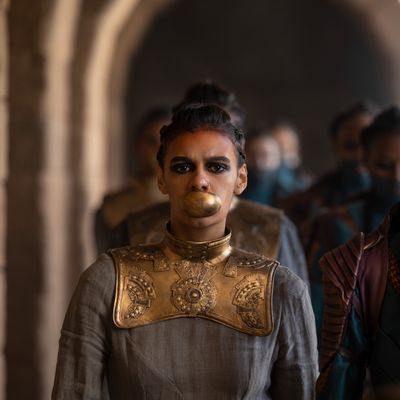
“It’s beautiful,” says the Forsaken called Ishamael, dying. “Do you see it, Lews?”
“What do you see?” replies Rand al’Thor, the reincarnation of Ishamael’s best friend turned bitterest enemy, Lews Therin, the Dragon Reborn.
“Nothing,” Ishamael says, smiling as his body crumbles away to dust. “Nothing at all.”
So ends a fascinating antagonist. A true nihilist, Ishamael was a man who, in The Big Lebowski’s memorable formulation, truly did believe in nothing. Aghast at the suffering inherent in life, his goal was to eliminate life, and thus suffering, forever. In the end, the only life ended was his own — and that only temporarily, if the Wheel of Time keeps on turning as it’s always done.
Still, what a lovely grace note for Ishamael, and for actor Fares Fares, who made him so charming and engaging a presence both in the lives of the other characters and simply on the screen.
And what better way to signal that Rand really has embraced his power as the Dragon Reborn than to have him simply walk through a torrent of sorcery and ice this dude without even trying? After all his scheming and bluster, Ishamael goes down with a simple stab to the chest, like the third enemy soldier from the right in any given battle scene. To paraphrase another villain, for Ishamael, this is the end of all his plots and hopes and suffering. For the Dragon Reborn, it’s Tuesday.
That’s the most interesting thing about the climax of The Wheel of Time’s marvelous second season, to me anyway. Written by showrunner Rafe Judkins and Timothy Earle and expertly directed across a wide canvas of action and spectacle by Sanaa Hamri, it introduces a different kind of ragtag epic-fantasy protagonist bunch: one in which they’re all the Incredible Hulk.
I get that other fantasy fans’ mileage may vary, and the appeal of the genre is to watch outmatched protagonists’ innate courage, decency, and resiliency win out over superior forces. Don’t get me wrong, I love that approach too — I’ve never once been able to sit through The Return of the King without crying multiple times as Frodo, Sam, Aragorn, Gandalf, & Co. march to all but certain doom in the hopes that their sacrifice stands a minuscule chance of ensuring the survival of others.
But there’s something to be said, a lot actually, for a story in which the good guys are all basically OP. Moraine flattening an enemy fleet singlehandedly, then unleashing a magical dragon-shaped fireworks display so huge and animated it puts the aforementioned Gandalf to shame. Egwene powering her way through the execution by hanging of her sul’dam, even though their magical link means she feels double the pain, then having enough left in her to deflect the mega-powerful Ishamael’s attacks even though she’s supposed to just be either a mere novice or a mere damane.
And Rand himself, lethally punking out Lord Turak and his personal guard in about two seconds, then executing the guy who’s supposed to be second only to the Dark One himself without breaking a sweat. Man, oh man, do I dig this. Superman as a selfless protector of the people of Metropolis is one thing. Superman as the leader of an army dedicated to destroying all evil forever? Sign me the hell up.
It doesn’t even stop there. Elayne proves her mettle by healing Rand from an accidental injury caused by Mat and seems to become one of Rand’s destined queens in the process. (A cursory glance at The Wheel of Time wiki indicates that Rand al’Thor and his childhood sweetheart Egwene have an understanding, so to speak, which is honestly pretty cool for a chosen-one story and which has already paid dividends in the emergence of Selene/Lanfear as a frenemy.)
Mat cleverly powers past his addiction to that cursed dagger — presented to him by Ishamael and his human servant Padan Fain in an attempt to reawaken the evil inside him and get him to kill Rand — by tying it to a pole and using it as a spear. He then wrecks shop with it, alongside the phalanx of ghostly “Heroes of the Horn” he summons by blowing the magical Horn of Valere when all seems lost. This is some of the most fun work we’ve seen from the talented actor Dónal Finn all season; he gets that Mat is a depressive character, and so when Mat has moments of joy and elation — whether that’s simply reuniting with his friends or realizing he was born to be the leader of the most legendary assemblage of heroes ever known — he really makes them almost radiate inner sunlight. It’s just a pleasure to see Mat happy.
Perrin gets into the act, too. Integral to getting the Horn in place and to fighting off the palace guards, he winds up getting a magical shield from his reanimated friend Uno (the one-eyed Scottish warrior who got his head split open with that spike earlier in the season). He then uses it to augment Egwene’s defense of Rand against Ishamael. Along the way, he avenges the death of his wolf buddy Hopper at the hands of the Whiteclock general Geofram Bornhald (Stuart Graham), though in the process, he makes a lifelong enemy of Geofram’s son Dane, with whom he’d developed an unlikely mutual respect. He seems to have taken his werewolf powers to a new level in the process, becoming as formidable a fighter in his own way as his Aiel pal Aviendha and her comrades-in-arms are in theirs.
The only character who fails to reveal end-of-game power levels is Nynaeve. She plays a small but important role, torturing a captured sul’dam into revealing Egwene’s location, but has become so frightened of her own power that she’s unable to use it at all. She resorts to physical techniques to take an arrow out of Elayne, then leaves the healing of Rand completely in Elayne’s hands. I’m not sold on this development — didn’t we just go through this with Moraine, in a way? — but it’s clear the contrast with her powered-up buddies is deliberate and will dictate Nynaeve’s course in season three.
Perhaps Loial put it best when he advised his pals to quit trying to do exactly what the heroes of old did, in a vain attempt to fulfill every letter of the prophecies they’re enacting, and simply start acting like “the heroes of today,” which is exactly what they are.
Again, I am so, so here for a big epic fantasy where the heroes know they’re the heroes and act accordingly. The Lord of the Rings and Game of Thrones mean the world to me, but we’ve already seen “little guys save the world against impossible odds” and “everyone is shades of gray, prophecy is a blade without a hilt, and your messiahs might be the most dangerous people of all.” “The Justice League wages a World War” is new and exciting.
(In case it isn’t obvious, no, I haven’t read the books, don’t know where this is all headed, and don’t know what’s been changed, and I’m fine with all that. The work on the screen is compelling, and that’s what matters most.)
All this plays out in the bright, broad daylight of a beachside kingdom. When Moraine and Lan re-form their severed bond, the sensual, borderline erotic magical melding that results takes place under gorgeous blue skies, with the wind off the waves tousling their hair. It’s one of the most romantic things I’ve seen on TV all year, and thanks to that lovely light, you really can see it!
Similarly, when Perrin, Loial, and their pals throw down against the Seanchan to protect Mat’s escape with the horn, they do so in an alleyway where you can actually see all the combatants and get a sense of their basic spatial relationships. It’s marked contrast with earlier fight scenes throughout this season (Moraine and Lan against the Fades in that graveyard, Perrin and Aviendha against the Whitecloaks in that town), as well as with the murky, COVID-19-handicapped final battle against the Trolloc hordes that capped off season one.
And on and on it goes. The deaths of Turak, Suroth, Renna, and Ishamael. The reunions of, well, everyone else with everyone else. The proclamation of the Dragon, wrought in fire wrapping itself around the city tower. In its moment of truth, The Wheel of Time smartly leaned into its strength as cinema — making things look bright and beautiful instead of flat and murky — and the benefits are everywhere to see.
The episode ends with a little stinger involving Lanfear discovering that Ishamael unleashed other, crazier Forsaken before his death. Specifically, he freed Moghedien (Laia Costa), a creepy little goth with TERF bangs and cool spiderweb powers who chumps Lanfear out pretty effortlessly.
But what it really ends with is a sense of possibility. The Wheel of Time is blazing a new path for fantasy on television — unmistakably epic, yet with markedly different influences and interests and emphasis than its predecessors. There are more cultural variables in play, there are more major heroes and villains at work, and the whole concept of, essentially, superheroes leading armies to save the world is a fun one. So too is a fantasy story in which most of the main characters are women and where women call the shots without much question. This is not at all to say that other approaches to gender in fantasy are invalid; the idea that this approach is superior to, say, House of the Dragon’s approach, instead of simply different, is dumb. But it is different, and that’s exciting!
So is The Wheel of Time, the second season of which has proved to be a sophomore surprise in the vein of Halt and Catch Fire, The Leftovers, Billions, and most recently, Foundation — shows whose shaky first seasons showed glimpses of promise that positively exploded in their follow-up outings. Wheel is now must-watch television.




